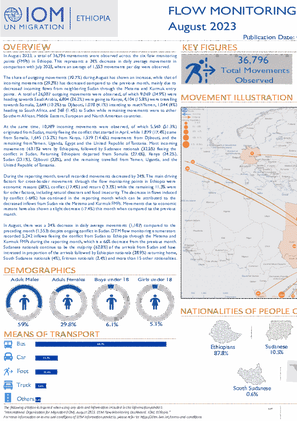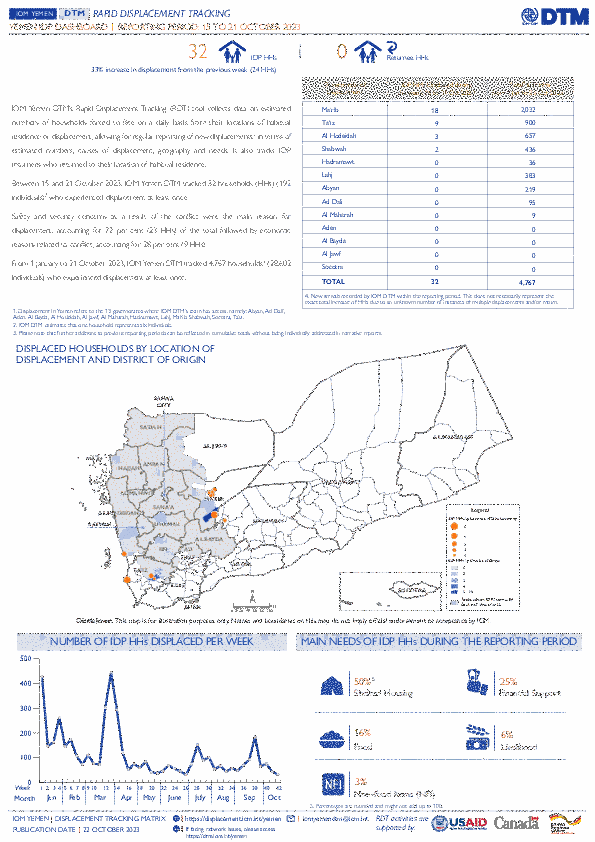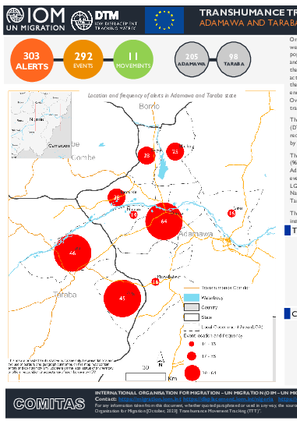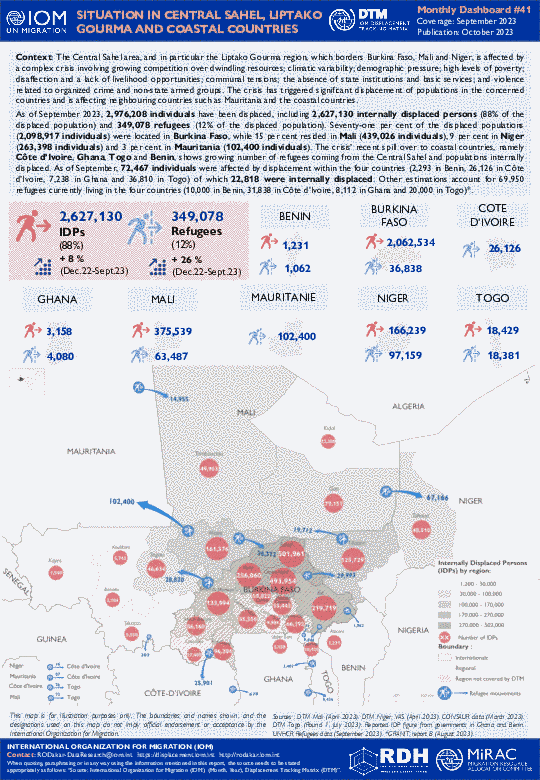-
Countries
-
Data and Analysis
-
Special Focus
-
Crisis Responses

Contact
DTM Ethiopia, DTMEthiopia@iom.int
Language
English
Location
Ethiopia
Period Covered
Aug 01 2023
Aug 31 2023
Activity
- Flow Monitoring
In August 2023, a total of 36,796 movements were observed across the six flow monitoring points (FMPs) in Ethiopia. This represents a 24% decrease in daily average movements in comparison with July 2023, where an average of 1,553 movements per day were observed.
The share of outgoing movements (70.7%) during August has shown an increase, while that of incoming movements (29.3%) has decreased compared to the previous month, mainly due to decreased incoming flows from neighboring Sudan through the Metema and Kurmuk entry points. A total of 26,007 outgoing movements were observed, of which 9,069 (34.9%) were heading towards Saudi Arabia, 6,804 (26.2%) were going to Kenya, 4,104 (15.8%) were travelling towards Somalia, 2,649 (10.2%) to Djibouti, 1,078 (4.1%) intending to reach Yemen, 1,044 (4%) heading to South Africa, and 368 (1.4%) to Sudan while remaining movements were to other Southern African, Middle Eastern, European and North American countries.
At the same time, 10,789 incoming movements were observed, of which 5,540 (51.3%) originated from Sudan, mainly fleeing the conflict that started in April, while 1,879 (17.4%) came from Somalia, 1,645 (15.2%) from Kenya, 1,579 (14.6%) movements from Djibouti, and the remaining from Yemen, Uganda, Egypt and the United Republic of Tanzania. Most incoming movements (63.1%) were by Ethiopians, followed by Sudanese nationals (32.5%) fleeing the conflict in Sudan. Returning Ethiopians departed from Somalia (27.6%), Kenya (24.2%), Sudan (23.1%), Djibouti (23%), and the remaining travelled from Yemen, Uganda, and the United Republic of Tanzania.
Contact
DTM Yemen, iomyemendtm@iom.int
Location
Yemen
Activity
- Mobility Tracking
Period Covered
Oct 15 2023 -Oct 21 2023
From 1 January to 21 October 2023, IOM Yemen DTM tracked 4,767 households (HH) (28,602 Individuals) who experienced displacement at least once.
Between 15 and 21 October 2023, IOM Yemen DTM tracked 32 households (192 individuals) displaced at least once. The majority of people moved into/within the following governorates and districts:
- Ma’rib (18 HHs) – Ma’rib (10 HHs), Harib (5 HHs), Ma’rib City (3 HHs) districts. Most displacements in the governorate originated from Ma’rib and Ibb.
- Ta’iz (9 HHs) – Al Makha (5 HHs), Jabal Habashi (3 HHs), Al Maafer (1 HH) districts. Most displacements in the governorate originated from Ta’iz and Ibb.
- Al Hodeidah (3 HHs) – At Tuhayta (3 HHs) district. All displacements in the governorate were internal.
- Ma’rib (13 HHs) – Harib (10 HHs), Al Jubah (2 HHs), Raghwan (1 HH) districts.
- Ta’iz (8 HHs) – Al Maafer (4 HHs), Sabir Al Mawadim (3 HHs), Jabal Habashi (1 HH) districts.
- Ibb (5 HHs) – Al Qafr (2 HHs), Badan (2 HHs), As Sabrah (1 HH) districts.
Population Groups
Survey Methodology
Unit of Analysis Or Observation
Type of Survey or Assessment
Keywords
Geographical Scope
Administrative boundaries with available data
The current dataset covers the following administrative boundaries

Contact
DTM Yemen, iomyemendtm@iom.int
Language
English
Location
Yemen
Period Covered
Oct 15 2023
Oct 21 2023
Activity
- Rapid Emergency Registration
- Mobility Tracking
IOM Yemen DTM’s Rapid Displacement Tracking (RDT) tool collects data on estimated numbers of households forced to flee on a daily basis from their locations of origin or displacement, allowing for regular reporting of new displacements in terms of estimated numbers, geography, and needs. It also tracks returnees who returned to their location of origin.
From 1 January to 21 October 2023, IOM Yemen DTM tracked 4,767 households (HH) (28,602 Individuals) who experienced displacement at least once.
Between 15 and 21 October 2023, IOM Yemen DTM tracked 32 households (192 individuals) displaced at least once. The majority of people moved into/within the following governorates and districts:
- Ma’rib (18 HHs) – Ma’rib (10 HHs), Harib (5 HHs), Ma’rib City (3 HHs) districts. Most displacements in the governorate originated from Ma’rib and Ibb.
- Ta’iz (9 HHs) – Al Makha (5 HHs), Jabal Habashi (3 HHs), Al Maafer (1 HH) districts. Most displacements in the governorate originated from Ta’iz and Ibb.
- Al Hodeidah (3 HHs) – At Tuhayta (3 HHs) district. All displacements in the governorate were internal.
The majority of people moved from the following governorates and districts:
- Ma’rib (13 HHs) – Harib (10 HHs), Al Jubah (2 HHs), Raghwan (1 HH) districts.
- Ta’iz (8 HHs) – Al Maafer (4 HHs), Sabir Al Mawadim (3 HHs), Jabal Habashi (1 HH) districts.
- Ibb (5 HHs) – Al Qafr (2 HHs), Badan (2 HHs), As Sabrah (1 HH) districts.

Contact
dtmpakistan@iom.int
Language
English
Location
Pakistan
Period Covered
May 01 2023
Jun 30 2023
Activity
- Survey
- Mobility Tracking
- Site Assessment
From June to October 2022, storms and heavy monsoon rains in Pakistan caused widespread flooding and landslides across the country. As of 18 November 2022, according to the National Disaster Management Authority (NDMA), up to 33 million people have been affected by the floods and a total of 90 districts have been labelled by the Government of Pakistan as ‘calamity-hit’.
Between May and June 2023, IOM implemented a third round of the CNI to provide partners with timely information on the displacement situation, the multisectoral needs of the affected population as well as the recovery needs at the settlement level. For this round, IOM implemented the CNI in nine districts of Balochistan. The CNI was conducted in 3,261 flood-affected settlements or settlements that hosted temporary displaced persons (TDPs) across the nine targeted districts.
Contact
DTMUkraine@iom.int
Location
Ukraine
Activity
- Survey
- Return Intention
Period Covered
May 01 2023 -Jun 30 2023
In round 3, out of the 156 return locations assessed, 25 recorded high severity conditions for one or more driver of severity. This equates to nearly a third of the estimated returnee population in assessed locations residing in high severity conditions (31%, 432,000 people).
This is a restricted dataset. To get access, kindly click on the 'Request Access' button.
Population Groups
Survey Methodology
Unit of Analysis Or Observation
Type of Survey or Assessment
Keywords
Geographical Scope
Administrative boundaries with available data
The current dataset covers the following administrative boundaries
Contact
DTMUkraine@iom.int
Location
Ukraine
Activity
- Survey
- Return Intention
Period Covered
Mar 01 2023 -Apr 30 2023
In round 2, out of the 117 return locations assessed, 23 recorded high severity conditions for one or more driver of severity. This equates to nearly a third of the estimated returnee population in assessed settlements residing in high severity conditions (29%, 499,000 people).
This is a restricted dataset. To get access, kindly click on the 'Request Access' button.
Population Groups
Survey Methodology
Unit of Analysis Or Observation
Type of Survey or Assessment
Keywords
Geographical Scope
Administrative boundaries with available data
The current dataset covers the following administrative boundaries
Contact
DTMUkraine@iom.int
Location
Ukraine
Activity
- Survey
- Return Intention
Period Covered
Jul 01 2023 -Aug 31 2023
In round 4 assessment, nearly a third of the estimated returnee population reside in locations which recorded high severity for one or more drivers of severity. This equates to approximately 680,000 people residing in high severity conditions in 57 locations, amidst 186 return locations assessed.
This is a restricted dataset. To get access, kindly click on the 'Request Access' button.
Population Groups
Survey Methodology
Unit of Analysis Or Observation
Type of Survey or Assessment
Keywords
Geographical Scope
Administrative boundaries with available data
The current dataset covers the following administrative boundaries

Contact
daibrahim@iom.int
Language
English
Location
Lebanon
Period Covered
Oct 10 2023
Oct 18 2023
Activity
- Mobility Tracking
- Baseline Assessment
Since October 8 there has been an increase in cross-border incidents between Israel and Lebanon, resulting in the displacement of people both within the South and elsewhere within the country. Since October 10, the Displacement Tracking Matrix (DTM) has been conducting the daily monitoring of population movements. The objective of the exercise is to inform preparedness and response planning.

Contact
DTM Nigeria, AllUsersInDTMNigeria@iom.int
Language
English
Location
Nigeria
Period Covered
Sep 01 2023
Sep 30 2023
Activity
- Survey
In northern Nigeria and other Sahel regions, the escalation of hostility and violent conflicts between transhumant herders and farmers are linked to several key factors. One of the main contributors is the competition over natural resources, which is exacerbated by the low rainfall, insecurity, insurgency, growing population and the attendant land-intensive demands for both farming and transhumance activities. Additionally, year-round farming and the conventional methods of land allocation to farming and herding activities add to the tensions, as farmers may encroach on designated grazing areas and routes, and herders in turn resort to destructive practices such as trespassing on farmlands, causing crop destruction and polluting water sources to feed their cattle. These factors sometimes result in deadly conflicts.
The Transhumance Tracking Tool (TTT) within the framework of IOM's Displacement Tracking Matrix (DTM) utilizes information provided by community Key Informants through a designated focal person to record alerts related to transhumance activities. This report showcases the early warning alerts collected by TTT in 9 Local Government Areas (LGAs) across Adamawa and Taraba states for September 2023.
The triangulated 303 alerts linked to transhumance related events for September 2023 comprises of 292 (96%) events and 11 (4%) movement alerts. The largest number of alerts were reported in Demsa LGA in Adamawa state (22%), followed by Zing LGAs (17%) and Lau (16%) in Taraba state. The disaggregated event alerts in the two states reveal that the highest reported events occurred in Monkin ward of Zing LGA in Taraba state, accounting for 6.5 per cent of the total. This was followed by Gwamba and Nassarawo Demsa wards in Demsa LGA of Adamawa, at 4.8 per cent each, and Zing ward in Zing LGA of Taraba state, which reported 4.1 per cent of the total event alerts.
The reported alerts suggested the instance of 1 per cent population displacement, while 15 per cent of the instances resulted in casualties or injuries.
The Central Sahel area, and in particular the Liptako Gourma region, which borders Burkina Faso, Mali and Niger, is affected by a complex crisis involving growing competition over dwindling resources; climatic variability; demographic pressure; high levels of poverty; disaffection and a lack of livelihood opportunities; communal tensions; the absence of state institutions and basic services; and violence related to organized crime and non-state armed groups. The crisis has triggered significant displacement of populations in the concerned countries and is affecting neighbouring countries such as Mauritania and the coastal countries.
As of September 2023, 2,976,208 individuals have been displaced, including 2,627,130 internally displaced persons (88% of the displaced population) and 349,078 refugees (12% of the displaced population). Seventy-one per cent of the displaced populations (2,098,917 individuals) were located in Burkina Faso, while 15 per cent resided in Mali (439,026 individuals), 9 per cent in Niger (263,398 individuals) and 3 per cent in Mauritania (102,400 individuals). The crisis’ recent spill over to coastal countries, namely Côte d’Ivoire, Ghana, Togo and Benin, shows growing number of refugees coming from the Central Sahel and populations internally displaced. As of September, 72,467 individuals were affected by displacement within the four countries (2,293 in Benin, 26,126 in Côte d’Ivoire, 7,238 in Ghana and 36,810 in Togo) of which 22,818 were internally displaced. Other estimations account for 69,950 refugees currently living in the four countries (10,000 in Benin, 31,838 in Côte d’Ivoire, 8,112 in Ghana and 20,000 in Togo)*.

